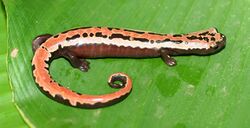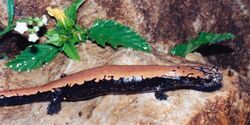Biology:Bolitoglossa
| Bolitoglossa | |
|---|---|

| |
| Bolitoglossa mexicana | |
| Scientific classification | |
| Domain: | Eukaryota |
| Kingdom: | Animalia |
| Phylum: | Chordata |
| Class: | Amphibia |
| Order: | Urodela |
| Family: | Plethodontidae |
| Subfamily: | Hemidactyliinae |
| Genus: | Bolitoglossa Duméril, Bibron & Duméril, 1854 |
| Species | |
|
c. 140, see text | |
Bolitoglossa is a genus of lungless salamanders, also called mushroom-tongued salamanders,[1] tropical climbing salamanders,[2] or web-footed salamanders,[3] in the family Plethodontidae.[1][4] Their range is between northern Mexico through Central America to Colombia, Venezuela, Ecuador, Peru, northeastern Brazil , and central Bolivia.[1] Neotropical salamanders of the Bolitoglossa make up the largest genus in the order Caudata,[5] consisting of approximately one-fifth of all known species of salamanders.[1] Adult salamanders range anywhere from 45mm to 200mm in length depending on their specific species.[6] They are notorious for their ability to project their tongue at prey items, as indicated from their name. They are also known for their webbed feet, having significantly more webbing than any other species outside their genus with the exception of the cave-dwelling Mexican bolitoglossine Chiropterotriton magnipes.[7] Although webbed feet are a common characteristic of these salamanders, only about half of the species in this genus contain webbed feet.[6]
Characteristics
Hand and foot morphology
Hand and foot morphology is strikingly diverse in an otherwise morphologically uniform group. While just under half of these species contain webbing between their fingers and toes, the remaining species experience little to no webbing and undergo elongation of their fingers and toes throughout development. Ultimately, the variation of foot morphology within this genus is primarily due to natural selection. Derived characteristics correspond to arboreal vs. terrestrial salamanders.[7]
- Webbed fingers – natural selection to improve terrestrial movement through water.
- Elongated fingers – natural selection of increased suction efficiency, favoring a larger surface area of the foot. This also selects for a decreased body size, enabling the salamander to cling trees more easily.
Tail autotomy
Tail autotomy refers to the salamanders' ability to release or lose their tail if necessary. This is a common characteristic of nearly all salamanders and lizards. (See autotomy). It is particularly helpful to the salamander in escaping attacks from its predators. Once the tail has been lost, it can regenerate one time. After this regeneration, the tail is incapable of separation with regeneration.[8]
Poison
Bolitoglossa rostrata and B. subpalmata are two rare examples of poisonous salamanders within their genus. The poison is secreted through their skin as an antipredator mechanism. It is particularly toxic to certain snake species, rendering them immobile and unresponsive to external stimuli upon initial contact. The common defense tactic of these two species is to remain still in the presence of the snake until it makes initial contact (usually by the flickering of its tongue), and then run away as the paralytic poison begins to take effect in the snake.[9]
Evolution
Natural selection
Tropical adaptation of the Bolitoglossa is thought to have evolved from North American plethodontids. Natural selection is responsible for morphological changes shifting from those supporting temperate environments to those supporting tropical environments such as Panama and Costa Rica.[10] Natural selection is thought to have resulted in genetic changes from physical adaptation. The main differences that have developed from natural selection affect the skull and bones of the feet in these salamanders. Due to these primary changes, secondary changes are believed to have followed, including:
- Body size
- Additional ossification of bones
- Webbing
- Ear structure
Phylogeny of this genus is partially dependent on its variations in bone structure due to the effects of natural selection over a long period of time.[11]
Hybridization
The first documented case of hybridization in tropical salamanders occurred between B. frankini and B. resplendens. This hybridization has taken a pervasive effect on the morphology of B. resplendens, whereas B. frankini seemed to maintain its same physical structure.[12]
Taxonomy

Derived characteristics of the genus Bolitoglossa has led to their classification based on this specific list of characters:
- Tongue and hypobranchial apparatus
- Epibranchial Number
- embryos having a single epibranchial
- Tail Autotomy
- Brain stem motor control
- Bone structure of Jaws, Cranial, and inner ear
- Chromosome number
- diploid number of chromosomes is 26
- Development
Classification of this genus is primarily accomplished through analysis of the salamanders' DNA. This has proven to be the most effective and accurate way of classifying this genus.[5]
Species
As of January 2024, there are 140 recognised species assigned to this genus.[1][4][13]
|
|
References
- ↑ 1.0 1.1 1.2 1.3 1.4 Frost, Darrel R.. "Bolitoglossa Duméril, Bibron, and Duméril, 1854". American Museum of Natural History, New York. http://research.amnh.org/vz/herpetology/amphibia/Amphibia/Caudata/Plethodontidae/Hemidactyliinae/Bolitoglossa.
- ↑ "Tropical climbing salamanders Bolitoglossa". HerpMapper. https://www.herpmapper.org/taxon/bolitoglossa.
- ↑ Huettmann, Falk (4 August 2015). Central American Biodiversity: Conservation, Ecology, and a Sustainable Future. Springer. p. 289. ISBN 978-1-4939-2208-6. https://books.google.com/books?id=jr9OCgAAQBAJ&pg=PA289.
- ↑ 4.0 4.1 "Plethodontidae". University of California, Berkeley. 2024. https://amphibiaweb.org/lists/Plethodontidae.shtml.
- ↑ 5.0 5.1 Devitt, Tom; David Wake (2007). "supergenus Bolitoglossa. Version 09 March 2007 (under construction)". The Tree of Life Web Project, tolweb.org. http://tolweb.org/supergenus_Bolitoglossa/68802/2007.03.09.
- ↑ 6.0 6.1 Alberch, Pere (1981). "Convergence and parallelism in foot morphology in the neotropical salamander genus Bolitoglossa. I. Function". Evolution 35 (1): 84–100. doi:10.1111/j.1558-5646.1981.tb04861.x. PMID 28563463.
- ↑ 7.0 7.1 Jaekel, M.; Wake, D. B. (2007). "Developmental processes underlying the evolution of a derived foot morphology in salamanders". Proceedings of the National Academy of Sciences of the United States of America 104 (51): 20437–20442. doi:10.1073/pnas.0710216105. PMID 18077320. Bibcode: 2007PNAS..10420437J.
- ↑ Ducey, Peter K.; Brodie, Edmund D. (1983). "Salamanders respond selectively to contacts with snakes: survival advantage of alternative antipredator strategies". Copeia 1983 (4): 1036–1041. doi:10.2307/1445106.
- ↑ Brodie, Edmund D. Jr.; Ducey, Peter K.; Baness, Elizabeth A. (1991). "Antipredator skin secretions of some tropical salamanders (Bolitoglossa) are toxic to snake predators". Biotropica 23 (1): 58–62. doi:10.2307/2388688.
- ↑ Ortega, Jesús E.; Monares-Riaño, John Maury; Ramírez-Pinilla, Martha Patricia (2009). "Reproductive activity, diet, and microhabitat use in Bolitoglossa nicefori (Caudata: Plethodontidae)". Journal of Herpetology 43 (1): 1–10. doi:10.1670/07-250R2.1.
- ↑ Alberch, Pere (1983). "Morphological variation in the Neotropical salamander genus Bolitoglossa". Evolution 37 (5): 906–919. doi:10.1111/j.1558-5646.1983.tb05620.x. PMID 28563544.
- ↑ Wake, David B.; Yang, Suh Y.; Papenfuss, Theodore J. (1980). "Natural hybridization and its evolutionary implications in Guatemalan plethodontid salamanders of the genus Bolitoglossa". Herpetologica 36 (4): 335–345.
- ↑ "Bolitoglossa". University of California, Berkeley. https://amphibiaweb.org/cgi-bin/amphib_query?query_src=aw_lists_genera_&table=amphib&where-genus=Bolitoglossa.
- ↑ "A beautiful new yellow salamander, genus Bolitoglossa (Caudata: Plethodontidae), from the northeastern slopes of the Cordillera de Talamanca, Costa Rica". https://www.researchgate.net/publication/309672631_A_beautiful_new_yellow_salamander_genus_Bolitoglossa_Caudata_Plethodontidae_from_the_northeastern_slopes_of_the_Cordillera_de_Talamanca_Costa_Rica.
External links
- AmphibiaWeb: Information on amphibian biology and conservation. [web application]. 2008. Berkeley, California: Bolitoglossa. AmphibiaWeb, available at http://amphibiaweb.org/. (Accessed: 29 July 2008).
Wikidata ☰ Q2670457 entry
 |

